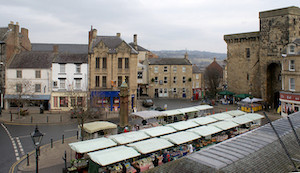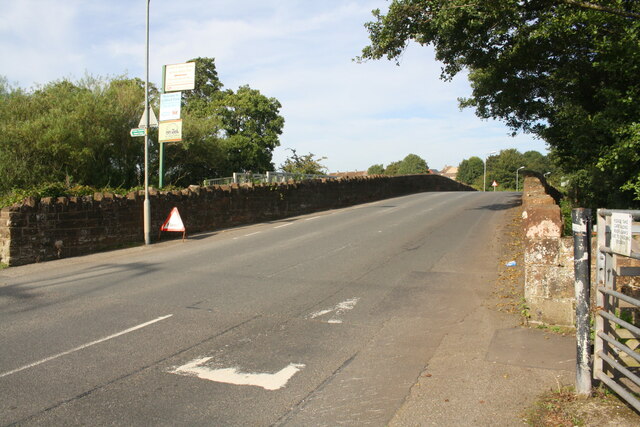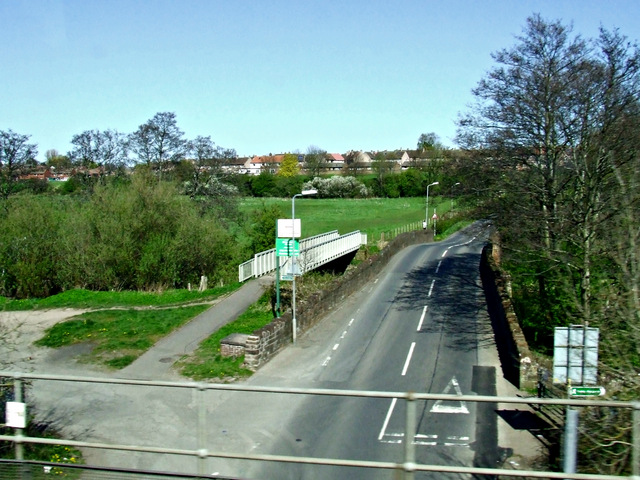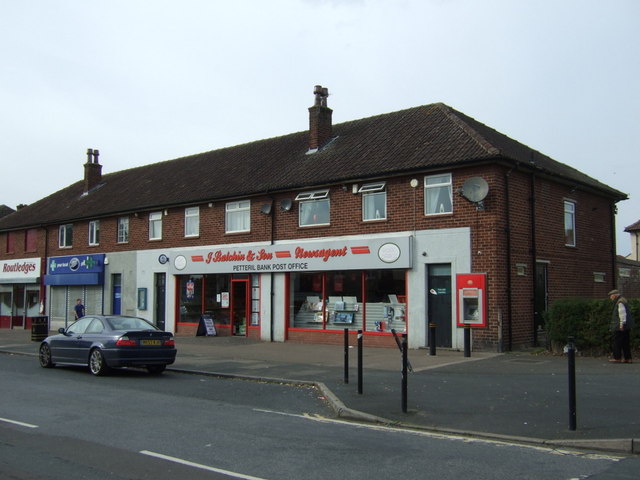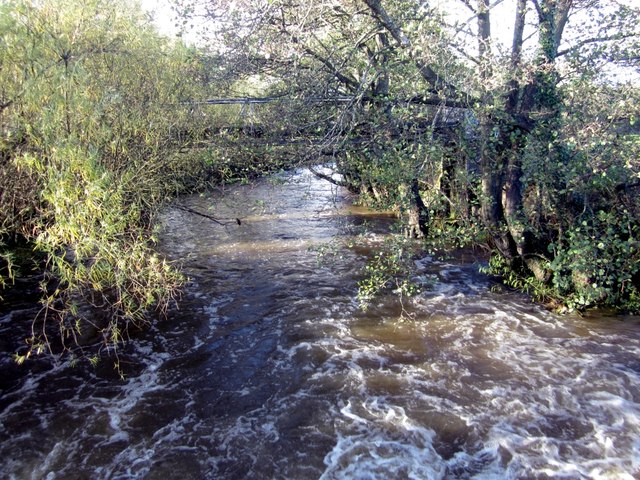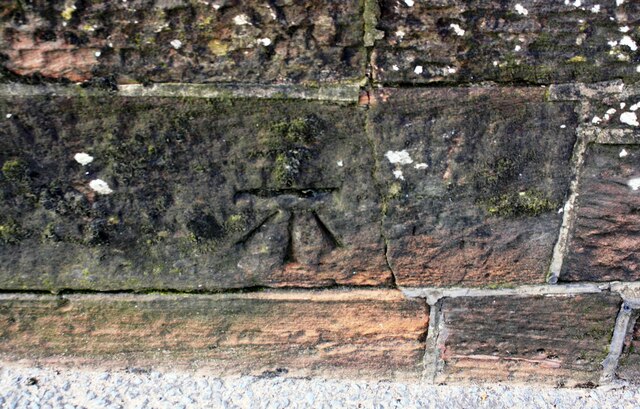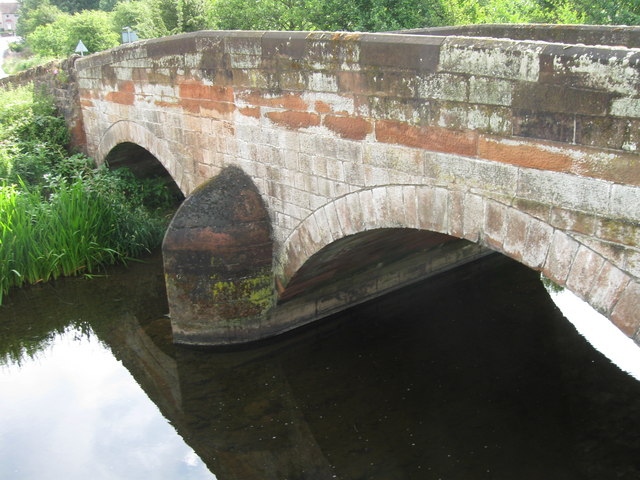Topics > Northumberland > Hexham > Hexham, 1848
Hexham, 1848
HEXHAM (St. Andrew), a market-town and parish, and the head of a union, in the S. division of Tindale ward and of Northumberland; containing 5,989 inhabitants, of whom 4,742 are in the town, 20 miles (W.) from Newcastle-upon-Tyne, and 283 (N.N.W.) from London. The origin of this place, which Camden supposes to have been the Axelodunum of the Romans, is, perhaps, with greater probability, referred to the Saxons, by whom it was called Hextoldesham and Halgustad, on account of the neighbouring streams Hextol and Halgut, from the former of which its present name is derived. Horsley fixes the station of Axelodunum at Brough, in Cumberland, and the supposition of Camden is not confirmed by any Roman relics, except a few inscribed stones, which have been obviously brought from some other place. About the year 673, Wilfrid, Archbishop of York, having obtained from Ethelreda, wife of Egfrid, King of Northumbria, a grant of the town, and a large adjoining tract called Hexhamshire, founded a monastery, and erected a church, which, according to Richard of Hexham, was the most magnificent ecclesiastical edifice in the kingdom. After the expulsion of Wilfrid from the see of York in 678, that province was divided, and Hexham erected into a see, which continued for more than a century, till, being united with Lindisfarne, it eventually became part of the see of Durham: it is now, however, a peculiar of York. Tilford, the last bishop of Hexham, was expelled from his bishopric in 821, by the Danes, who, about 50 years afterwards, destroyed the monastery and plundered the town. The monastery was restored for Augustine canons in 1112, and Hexham, together with Holme, was appropriated to the endowment of a prebendal stall in the cathedral of York. In 1138, the Scots (under David I.) pillaged the monastery, and in 1296, again attacking the town, burnt the monastery and the nave of the conventual church. In the reign of Henry VIII., the last prior of Hexham, having been involved in the insurrection called the Pilgrimage of Grace, was hanged at the gate of the monastery in 1536: at the Dissolution the revenue was £138.1.9.
Hexham possessed all the rights and privileges of a county palatine, which, with the jura regalia, were confirmed by Edward I. In the reign of Edward III., the town was again plundered by an army of 40,000 Scots, under the command of David II., who was taken prisoner by Sir John Copeland, then sheriff of Northumberland, at the battle of Nevill's Cross. In 1463, the decisive battle of Hexham was fought on the plains near the town, between the Yorkists and Lancastrians, the former of whom, commanded by Lord Montacute, defeated the latter under the Duke of Somerset, who was taken prisoner, and beheaded. Hexham, with its adjoining district, coming into the possession of the crown by an exchange with the Archbishop of York, was in the 14th of Elizabeth annexed to the county of Northumberland. A dreadful riot happened here on the 9th of March, 1761, when 5000 persons, principally miners, assembled to obstruct the magistrates; 48 persons were killed by the North York militia, and 300 persons wounded.
The Town, which is irregularly built, consists of several streets (diverging from an extensive marketplace in the centre), partially paved, and first lighted in January, 1831; the inhabitants are supplied with water conveyed from a considerable distance into two reservoirs. The bridge here over the river Tyne is a handsome stone structure of nine principal arches, with three smaller ones on the south side. A suspension bridge was constructed in 1826 over the South Tyne, near the western ferry, at an expense of £5000; and a bridge of two arches has been recently erected at Gilligate, where the Cowgarth and Cockshaw burns unite their streams. The Vale of Tyne is beautifully diversified with wellcultivated fields, shrubberies, and pleasure-grounds, and is remarkable for producing earlier crops than the surrounding district: a considerable portion of the land belongs to the Commissioners of Greenwich Hospital. A mechanics' institute, with a library, was established in 1825. The principal branches of trade are, the dressing of leather, and the making of gloves, for which the town has long been in high repute; tanning is carried on to a considerable extent, and the tan-yard of Mr. Smith Stobart, the maker of the well-known "HexhamTan" gloves, has been established more than half a century. There are also two woollen factories, a manufactory for hats, and a brewery. The Hareshaw iron-works were established in July, 1839, chiefly for the purposes of heavy machinery and light castings: the proprietors possess four coal-pits, ironstone-works, and a blastfurnace, at Bellingham, 16 miles distant. Here is a station of the Newcastle and Carlisle railroad: the building is of rustic design. The market-days are Tuesday and Saturday, the former for corn; and a large cattlemarket is held every alternate Tuesday, from the end of February to Midsummer, and from October to Christmas: the market-house is a commodious building, with a piazza. The fairs are on August 6th and November 9th, for horses, cattle, sheep, and swine.
Though the town never received a charter of incorporation, there are four trading companies, viz., of weavers, shoemakers, glovers, and hatters, exercising, by a kind of prescriptive right, as great a control over those respective trades as is generally practised in towns regularly incorporated. A bailiff, appointed by the lord of the manor, presides at the manorial courts, and holds his office generally for life. A court of record is held within a month after Easter and at Michaelmas, for the recovery of debts to any amount, at which the steward of the manor, who must be a barrister, presides: a side court is likewise held four times in the year, or oftener if requisite, for the recovery of debts under 40s., at which the bailiff presides. Courts leet and baron for the manor of Anick-Grange, which is partly within this parish, are held here; as are also the Midsummer quarter-sessions for the county, and a petty-session for Tindale ward on the first Tuesday in the month. The powers of the county debt-court of Hexham, established in 1847, extend over nearly the whole of the registrationdistrict of Hexham. The town-hall is an ancient edifice, formerly the court-house of the bishops, in which the manor courts and quarter-sessions are held, and prisoners for debt are occasionally confined: at a small distance from it is an old tower, supposed to have been built for the defence of the monastery, and now used as the manor office. In Gilligate is a house of correction for the county, which was repaired, with the addition of a new wing, a few years since. The town is the place of election for the southern division of the county.
The parish comprises 4608 acres, of which 30 are common or waste land. The living is a perpetual curacy; net income, £139; patron, H. S. Le Strange, Esq.: the tithes of Hexham township have been commuted for £550. In 1623, Richard Fishborne left a sum of money in trust to the Mercers' Company for the endowment of a lectureship, with which the corn tithes of Erringside, anciently belonging to the monastery, were purchased. The church, which is part of the conventual church, built on the site of the cathedral, is a spacious cruciform structure, exhibiting portions in various styles of English architecture, with a tower rising from the intersection; the nave, burnt by the Scots in 1296, has not been rebuilt. The choir is separated from the transepts by a screen of wood, richly carved in the lower part, and ornamented in the upper with an allegorical painting of the Dance of Death. On the south side of the altar, which is lighted by a large window of elegant tracery, is a gallery of oak, beautifully carved, beneath which are four stalls enriched with tabernacle work; and on the north side is a shrine, or oratory, in the decorated English style, exquisitely adorned with foliated arches, tracery, and figures, and supposed to have been erected for Prior Richard, of Hexham, to whom, also, is attributed a recumbent figure on an altar-tomb adjacent. Among the monuments is one said by Pennant and others to be that of Elfwald, a Northumbrian king, who was killed in 788; but its style appears to be of the thirteenth century. On an altar-tomb is the figure of an armed knight, crosslegged, with a shield of arms identifying the person represented as one of the baronial family of Umfraville; though the effigy is supposed by Wallis, the historian, to be that of the Duke of Somerset, beheaded at Hexham. There are places of worship for Independents and Wesleyans; a Scottish church; and a Roman Catholic chapel, an elegant structure in the decorated English style, built in 1830.
The grammar school was founded in 1599, by Queen Elizabeth, who placed it under the control of an incorporated body of governors; it has an endowment of £21. 17. 2½. per annum. A bequest of £10 per annum, for apprenticing children, was made by Lady Anne Radcliffe; and there are other sums for distribution among the poor. The union comprises 69 parishes or places, and contains 27,929 inhabitants. Near a spot called St. Mary's Chare are some remains of the church founded by Wilfrid in 678, and dedicated to the Blessed Virgin. An immense number of stycas, or Saxon coins, were discovered in the churchyard of Hexham in 1833. John, prior of Hexham in the twelfth century, wrote the history of the reign of Henry II.; and his successor, Richard, was the author of several historical works. Joseph Richardson, the dramatist, who died in 1803, was a native of the parish; and John Tweddell, who greatly distinguished himself as a classical scholar and an antiquary, was born in 1769, at Threepwood, near the town.
Extract from: A Topographical Dictionary of England comprising the several counties, cities, boroughs, corporate and market towns, parishes, and townships..... 7th Edition, by Samuel Lewis, London, 1848.

from https://openlibrary.org/books…
A topographical dictionary of England, Samuel Lewis, 7th Ed., 1848
- A topographical dictionary of England
comprising the several counties, cities, boroughs, corporate and market towns, parishes, and townships, and the islands of Guernsey, Jersey, and Man, with historical and statistical …
Added by
Simon Cotterill


from https://openlibrary.org/books…
A topographical dictionary of England, Samuel Lewis, 7th Ed., 1848
- A topographical dictionary of England
comprising the several counties, cities, boroughs, corporate and market towns, parishes, and townships, and the islands of Guernsey, Jersey, and Man, with historical and statistical …
Added by
Simon Cotterill

